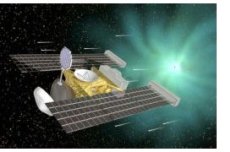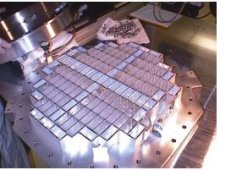22C3 Update: What happened to the video recordings and when will they be available? 04.02.2006
Some folks are starting to complain again as the video recordings of the 22. Chaos Comuncation Congress 2005 are not available yet.
The recordings are not lost, they are indeed complete and in a very good condition - but only on the 400 digital video tapes. As the 22C3-video crew from the Streamingteam of FeM e.V. tells us in this posting, there is an easy explanation to this. They started working on the recordings straight after the congress and soon had to realise, that almost all of the recordings that they made live through ffmpeg etc. were corrupted: The audio and video is just not in sync and it this wrong sync is changing all through the recordings so nobody can shift video and audio until its okay again.
Here’s what they did than:
So we engaged DEFCON 4 and got back on our backup solution that was there, just in case the open source would not work (who would have thought that?!).
So what’s DEFCON 4? We came to the congress with 400 brand new DV tapes. And that’s simply our backup solution: Everything that was recorded on the 22c3 is on DV tape. And it’s in sync there.
So we are extracting nearly all of the recordings from those DV tapes…
And as you can imagine: that takes time. It takes less time than we’d expected - so we are making serious progress. Together with the CCC it was decided that an intro and outro should be added to each recording - that also takes some time. If you are experienced in creating scripted/batched DV material with definable text… we obviously need your help :-)
So when will the recordings be available? We hope very very soon. Like I said we are making good progress in getting the stuff from the tapes but it’s very difficult to give a time line. Check back here for updated information - … well if we can get the intro/outro issue working fast it’ll probably be only days away.
Source and Weblink: http://www.schrankmonster.de/ […]
Read more about the fileformats and codecs of the 22C3-recordings here: http://events.ccc.de/2006/01/09/22c3-recordings-and-slides/
NASA: distributed computing with Stardust@Home 01.02.2006
Want to help at NASA’s comet sample return mission? Remember “SETI@home” where internet users shared CPU usage of their home computers to help searching for artificial radio wave signals in the universe? You can answer at least one of two questions with “yes”? Than here might be something interesting for you: Now you can be part in an Internet-based search for dust grains originating from stars hundreds of thousands of light years away.
 In a new project called “Stardust@home” researchers from the University of California, Berkeley, invite Internet users to help them search for a few dozen submicroscopic grains of interstellar dust captured by NASA’s “Stardust” spacecraft which returned to Earth on January 15th, 2006. The Stardust spacecraft collected not only interstellar dust particles, but dust from the tail of comet “Wild 2″ as well. It is expected, that the dust is dating from 10 million to 4.5 billion years ago.
In a new project called “Stardust@home” researchers from the University of California, Berkeley, invite Internet users to help them search for a few dozen submicroscopic grains of interstellar dust captured by NASA’s “Stardust” spacecraft which returned to Earth on January 15th, 2006. The Stardust spacecraft collected not only interstellar dust particles, but dust from the tail of comet “Wild 2″ as well. It is expected, that the dust is dating from 10 million to 4.5 billion years ago.
On February 15th, 2006 scientists will start scanning the dust collector and on March 1st, 2006 the first image data will be available for searching. The search will probably be completed in October 2006.
 Based on previous measurements of interstellar dust by both the Ulysses and Galileo spacecrafts, scientist expect to find approximately 45 grains of submicroscopic dust in the collector, a mosaic of tiles of lightweight aerogel forming a disk. Though those searching for pieces of Wild 2’s tail will easily be able to pick out the thousands of cometary dust grains embedded in the front of the detector, finding the 45 or so grains of interstellar dust stuck in the back of the detector won’t be so easy.
Based on previous measurements of interstellar dust by both the Ulysses and Galileo spacecrafts, scientist expect to find approximately 45 grains of submicroscopic dust in the collector, a mosaic of tiles of lightweight aerogel forming a disk. Though those searching for pieces of Wild 2’s tail will easily be able to pick out the thousands of cometary dust grains embedded in the front of the detector, finding the 45 or so grains of interstellar dust stuck in the back of the detector won’t be so easy.
The Space Sciences Laboratory has created a “virtual microscope” that will allow anyone with an Internet connection to scan some of the 1.5 million pictures of the aerogel for tracks left by speeding dust. Each picture will cover an area smaller than a grain of salt.
 “Twenty or 30 years ago, we would have hired a small army of microscopists who would be hunched over microscopes focusing up and down through the aerogel looking for the tracks of these dust grains,” said Westphal. “Instead, we developed an automated microscope to scan the aerogel and hope to use volunteers we have trained and tested to search for these tracks.”
“Twenty or 30 years ago, we would have hired a small army of microscopists who would be hunched over microscopes focusing up and down through the aerogel looking for the tracks of these dust grains,” said Westphal. “Instead, we developed an automated microscope to scan the aerogel and hope to use volunteers we have trained and tested to search for these tracks.”
The Web-based virtual microscope will be made available to the public in mid-March, even before all the scans have been completed in a cleanroom at Houston’s Johnson Space Center. In all, Westphal expects to need some 30,000 person hours to look through the scanned images at least four times. Searching each picture should take just a few seconds, but the close attention required as the viewer repeatedly focuses up and down through image after image will probably limit the number a person can scan in one sitting.
 Once the grains are identified and analyzed, scientist hope, that the information will tell about the internal processes of distant stars such as supernovas, flaring red giants or neutron stars that produce interstellar dust and also generate the heavy elements like carbon, nitrogen and oxygen necessary for life.
Once the grains are identified and analyzed, scientist hope, that the information will tell about the internal processes of distant stars such as supernovas, flaring red giants or neutron stars that produce interstellar dust and also generate the heavy elements like carbon, nitrogen and oxygen necessary for life.
In recognition of the critical importance of the Stardust@home volunteers, the discoverer of an interstellar dust particle will appear as a co-author on any scientific paper by the Stardust@home collaboration announcing the discovery of the particle.
Weblinks:
- Stardust@home: http://stardustathome.ssl.berkeley.edu/
- NASA’s Stardust Mission: http://stardust.jpl.nasa.gov/home/
- The Story of Stardust@Home
- Planetary Radio: Stardust Samples Streak Safely Home
Finally a Weblog I can understand ;-) 31.01.2006
Quotation from http://huuuuuurrnnnnnnnnnnn.blogspot.com/:
AAAAAAAAaaa rrrrrrrrrrrrrnnnnnnnnnnhhhh, HHHurrRRRRRRRRnhhhh. UUUHHHGGG-rrrr! UUUHHHGGG-rrrrRRR! UUUHHHGGG-rrrrRRR! HHHurrRRRRRRRRnhhhh. AAAAAAAAaaa rrrrrrrrrrrrrnnnnnnnnnnhhhh!
No need to explain more. Or?
[via Webmaster-Blog]
Podcasters tools - record 16 Bit digital audio with Video-iPod 13.01.2006
For our English speaking visitors: (more…)
| Ältere Artikel »
flickr images with "22C3"-tag:











